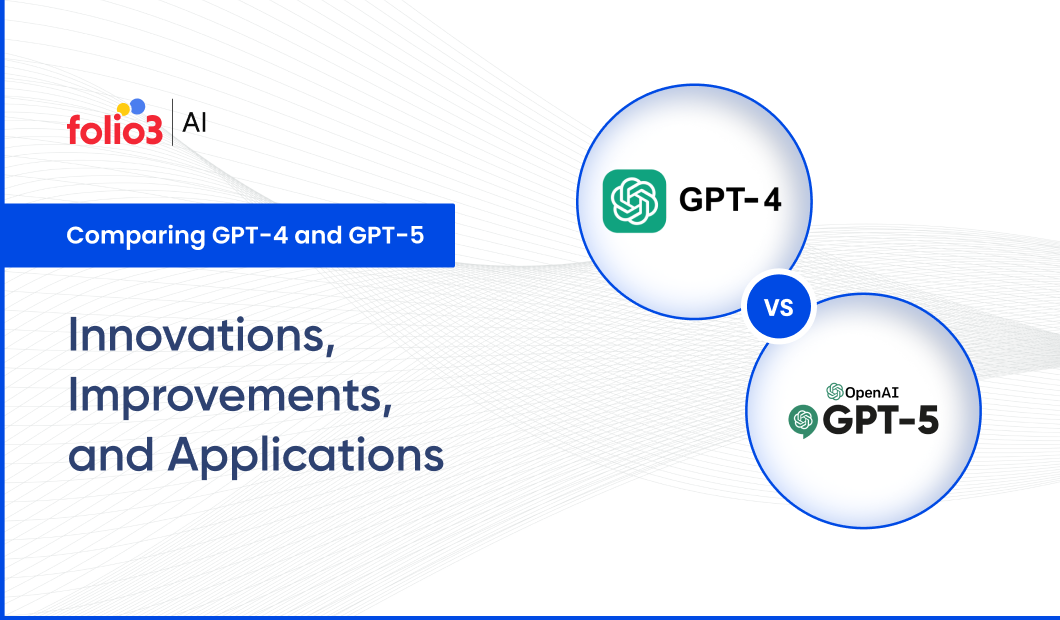As AI technology evolves, OpenAI’s Generative Pre-trained Transformer (GPT) models have consistently pushed the boundaries of natural language processing (NLP). GPT-4, the latest publicly available version, has proven to be a game changer in various industries. However, the anticipation for GPT-5 is palpable, with experts expecting even more groundbreaking innovations. This blog focuses on the key differences between GPT-4 and GPT-5, drilling down on innovations, improvements, and real-world applications.
Introduction
We interact with artificial intelligence through GPT models, which are based on the Transformer architecture. Each iteration from GPT-1 to GPT-4 has brought incremental improvements in language understanding, context sensitivity, and human-like responses.
GPT-4, the current model, has been widely successful across a variety of applications—ranging from customer service to advanced content creation and even programming assistance.
However, with the ever-increasing demand for more sophisticated AI systems, GPT-5 is expected to set new standards in terms of capabilities and performance.
Industry experts are particularly excited about GPT-5’s expected improvements in handling more complex tasks and its ability to generate nuanced and diverse outputs.
OpenAI, the company behind these GPT models, has become a significant player in developing advanced AI systems.
Through the release of various GPT models, OpenAI has impacted industries across the globe—from healthcare and law to entertainment and finance.
Each model has brought about new possibilities, but GPT-5 is expected to push the envelope even further, potentially changing the landscape of AI-powered applications in unprecedented ways.
Here’s a table summarizing the expected key differences between GPT-4 and GPT-5:
| Feature | GPT-4 | GPT-5 (Expected) |
Model Size | ~170B parameters | Possibly exceeding 500B parameters |
| Architecture | Transformer-based architecture | Graph neural network and attention-based architecture |
| Training Techniques | Supervised learning | Unsupervised learning from diverse and extensive datasets |
| Language Modeling Capabilities | Generates coherent text | Generates nuanced and complex language, including sarcasm and irony |
| Multilingual Support | Primarily for English | Comprehensive multilingual support |
| Context Understanding | Strong but limited in complex scenarios | Superior contextual depth and nuance |
| Performance & Efficiency | Optimized but resource-intensive | Faster, more efficient with lower resource usage |
| Training Data | Broad but not exhaustive | Larger and more diverse datasets |
| Bias & Ethical Considerations | Improved but issues persist | Further reductions in bias, better ethical frameworks |
| Use Cases | Generalized across sectors | More specialized, including healthcare and education |
| Energy Efficiency | High energy consumption | Likely more energy-efficient |
| Applications | Content generation, chatbots, coding | Enhanced applications in multilingual translation, creative arts, and personalized education |

Key Features of GPT-4
GPT-4 introduced advanced features that significantly improved language understanding and task versatility. One of its standout capabilities was the enhanced ability to comprehend and respond to more complex language queries, making it a versatile tool for numerous applications.
The model could handle tasks like text summarization, translation, sentiment analysis, and even coding assistance.
GPT-4 also demonstrated a better understanding of context compared to its predecessors, allowing it to provide more logical and relevant responses.
It improved on several fronts, such as reasoning skills, mathematical problem-solving, and its ability to hold conversations over longer sessions with fewer context breaks.
Industries like customer service, content generation, and software development have seen massive benefits from GPT-4.
For instance, companies now use GPT-4-powered chatbots to provide seamless customer support. In the field of content creation, GPT-4 aids in writing articles, blogs, and reports faster and more efficiently.
Coders, too, find it helpful for auto-generating code snippets or debugging existing code, making software development faster and less error-prone.
Advancements in GPT-5
While GPT-4 brought remarkable improvements, GPT-5 is expected to introduce even more significant advancements.
One of the most anticipated features of GPT-5 is its expected increase in model size, potentially exceeding 500 billion parameters, which will greatly enhance its ability to understand and generate more complex language structures.
GPT-5 is also expected to show an even deeper understanding of context, enabling it to handle more intricate conversations and tasks.
This includes not just processing larger amounts of text but also providing more nuanced and varied outputs, making it an even better tool for problem-solving in professional fields.
GPT-5 is expected to feature a hybrid architecture combining graph neural networks (GNNs) and attention-based mechanisms.
This evolution from GPT-4’s Transformer architecture is expected to enhance GPT-5’s ability to understand relationships between different entities and concepts, leading to a more intuitive understanding of context, language subtleties, and even emotions like sarcasm and irony.
GPT-5 also transitions from supervised learning to unsupervised learning, drawing from a more diverse and extensive dataset.
This makes GPT-5 more adaptable, allowing it to learn from an even broader range of text, including multilingual datasets, without the need for manually labeled training data.
Industries such as healthcare, legal analysis, and personalized education stand to benefit from GPT-5’s advancements.
Its enhanced ability to understand complex relationships and its more sophisticated problem-solving capabilities could revolutionize how professionals in these fields interact with and leverage AI.
For instance, doctors could use GPT-5 to assist in diagnosing conditions based on vast medical data, while lawyers might employ it for legal research, drafting documents, or analyzing case precedents.
Performance and Efficiency
When comparing GPT-4 and GPT-5, performance and efficiency stand out as critical areas of improvement. GPT-4, though powerful, still demands substantial computational resources.
Its performance is remarkable, but it can struggle with larger, more complex queries due to the limitations of its architecture.
GPT-5, however, is expected to surpass GPT-4 in both processing speed and efficiency. Leveraging more advanced hardware and optimization techniques, GPT-5 could significantly reduce the time required to generate responses, all while consuming fewer computational resources.
This could make GPT-5 not only faster but also more accessible and cost-effective.
The efficiency of GPT-5 will likely impact cloud computing costs and energy usage.
As the need for faster, more efficient AI models grows, reducing resource consumption becomes crucial. GPT-5’s anticipated efficiency improvements could lead to a reduction in energy costs, benefiting both users and the environment.
Accuracy and Training Data
Another critical improvement for GPT-5 will be in terms of accuracy and training data. GPT-4, while accurate in most scenarios, still faces challenges in specific niche areas, often producing outputs that may lack precision.
The training data used for GPT-4 was vast, but GPT-5 is expected to be trained on an even larger and more diverse dataset.
GPT-5 is also likely to handle bias better, with enhanced mechanisms to reduce the propagation of harmful or inaccurate information.
The increased dataset diversity in GPT-5 should improve the model’s ability to provide more accurate, fair, and balanced outputs across a broader range of topics.
Regarding multilingual capabilities, GPT-4 already supports a wide range of languages. However, GPT-5 is expected to expand on this, with improved accuracy and fluency in more languages, opening up opportunities for better cross-cultural communication and localization in industries like marketing, education, and customer service.
Use Cases and Applications
GPT-4 has already established itself in a wide range of use cases. From content creation to customer support, it has made complex tasks more manageable and accessible. However, GPT-5 is expected to open up even more possibilities, particularly in industries that require more specialized, high-stakes outputs.
For instance, the finance industry could benefit from GPT-5’s enhanced data processing and pattern recognition, enabling better market analysis and predictions. Similarly, the creative arts sector could see GPT-5 producing more sophisticated narratives, music compositions, or even visual art concepts.
Other emerging industries that could see increased use of GPT-5 include fields like legal research and advanced engineering. The improved problem-solving and contextual understanding in GPT-5 might allow it to assist professionals in these industries with more specialized, high-level tasks that require accuracy and deep domain knowledge.
Ethical Considerations
As AI models grow in complexity, ethical considerations become increasingly important. GPT-4 made notable improvements in addressing bias, privacy, and responsible AI usage, but these challenges persist. With GPT-5, OpenAI is expected to introduce even stronger safeguards to ensure that the model behaves ethically.
By training GPT-5 on more diverse datasets and implementing more advanced bias detection mechanisms, the model will likely reduce unintentional bias in its outputs.
However, the potential for misuse, as with any powerful AI, still exists, and OpenAI must continue working on robust strategies for ensuring responsible use.
Despite these advancements, challenges will remain in areas like AI ethics, privacy, and the potential for misuse.
GPT-5 will likely address some of these issues through stronger guardrails and better user controls, but the ongoing debate around AI’s role in society and how to govern its use responsibly will continue to evolve.
Conclusion
GPT-4 has proven to be a powerful tool with wide-reaching applications, but GPT-5 is poised to bring even more significant advancements. From improved context understanding to enhanced efficiency and ethical safeguards, GPT-5 will likely set a new standard in AI capabilities.
As GPT-5 rolls out, the implications for industries and applications across the globe are immense. Whether it’s enhancing conversational agents, generating more nuanced content, or offering better translation services, GPT-5’s capabilities are bound to reshape how we think.

FAQS
GPT-5 is expected to have more parameters, better contextual understanding, improved efficiency, and support for more languages compared to GPT-4.
The key differences between GPT-4 and GPT-5 include pricing, where GPT-5 may initially be more expensive due to its larger model size and advanced https://www.folio3.ai/blog/panoptic-segmentation-vs-instance-segmentation/capabilities. However, its improved efficiency could reduce long-term costs, making it more cost-effective over time, especially for large-scale applications.

Dawood is a digital marketing pro and AI/ML enthusiast. His blogs on Folio3 AI are a blend of marketing and tech brilliance. Dawood’s knack for making AI engaging for users sets his content apart, offering a unique and insightful take on the dynamic intersection of marketing and cutting-edge technology.









